The Colour Question
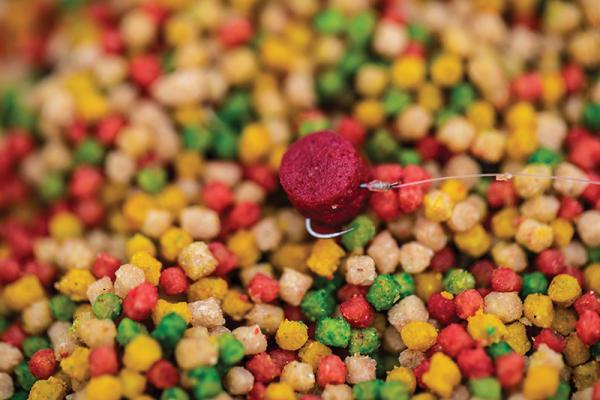
We are more similar to fish than we might think. I have been doing a lot of experimenting with bait colour recently and have come to the conclusion that – much like humans – fish respond to it in interesting and sometimes seemingly irrational ways.
I’ve had days when I can catch a fish a chuck on a pink wafter, but not get a bite on a yellow one. Likewise, when maggot fishing in winter, on some days a red maggot will catch you a fish every put in, but it’s hard to muster a bite on a white one.
But WHY?
It doesn’t make any sense. A lake full of hungry fish and it would seem they point blank refuse to eat certain colours, but mop up others with gay abandon. I gave up a long time ago trying to understand fish, we just need to learn their behaviour. Like humans, they have certain presets, which trigger at different points.
For example, I love a good lamb balti. Would I eat it if it came out the kitchen radon green? Or fluorescent blue? Probably not. But then again, I would wolf down a blue or a green Smartie…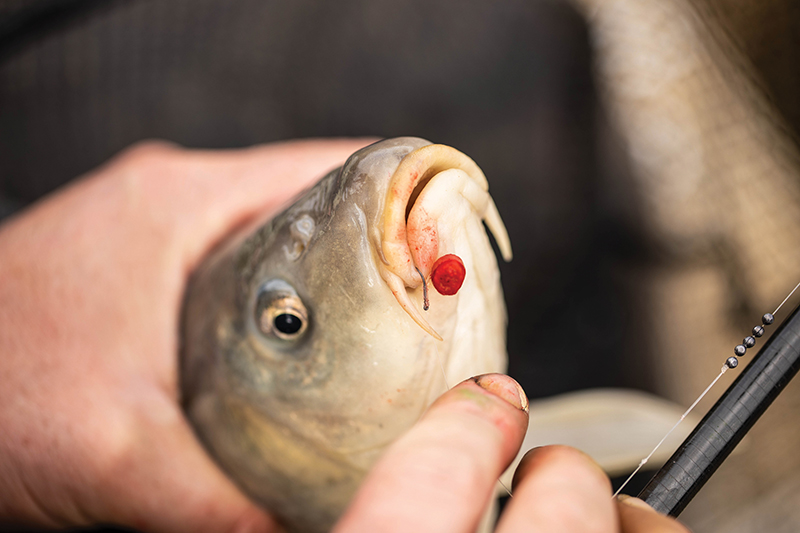 Take a long hard think about your own relationship with colour and you will probably find similar irrational feelings or behaviours. The idea of a bright blue curry positively repulses me, but I’m fine with a blue sweet.
Take a long hard think about your own relationship with colour and you will probably find similar irrational feelings or behaviours. The idea of a bright blue curry positively repulses me, but I’m fine with a blue sweet.
Nature has trained us as humans and animals to respond in this way to colour. Some things pull us in and others, if you excuse the pun, are like a red rag to a bull…
Catching Anglers….
We’ve all heard the cynics in the local tackle shop: “That bait’s just there to catch anglers.”
The best baits are inevitably marketed very well, and so of course they look appealing to us. But the true acid test can only begin when you get bait on the bank. And of course, we can’t judge anything on one session. It can be a big mistake to write something off after a poor first attempt, as I have found out the hard way on numerous occasions.
There is also a fine line to tread between falling victim to some colour-savvy marketeer, and neglecting that most important part of any angler’s armoury – confidence. If an angler thinks a bait will work for him, it invariably does.
So what I’m getting round to is that there are two forces at work here. What the fish like, and what we like. Just because someone tells you a certain colour works for them, it might just be because they like it and (consciously or subconsciously) give it preferential treatment. And likewise, if they tell you that a particular colour is rubbish, it could be that they have tried it once, then discarded it. My best advice is to trust no one, and let your own experience be your master.
With the above disclaimer in place, I feel I can begin cautiously to reveal what I have found during my recent experiments…
Match The Hatch
My ‘baseline’ as an angler is that you always want to ‘match the hatch’. The key to catching big weights of fish is making your hook bait perfectly match your feed – both in terms of how it looks in your hand, and how it falls through the water.
When David Preston first sent me samples of his Sensate Bait Dye, I straightaway thought this could prove an advantage here. Think fishery micros and expander pellets. Often, the expanders are quite a bit lighter than the micros in my experience. By giving the micros, and the expanders a liberal dose of bait dye, I could make them all exactly the same colour, and give them a boost of extra Sensate Attractant. What’s not to like? 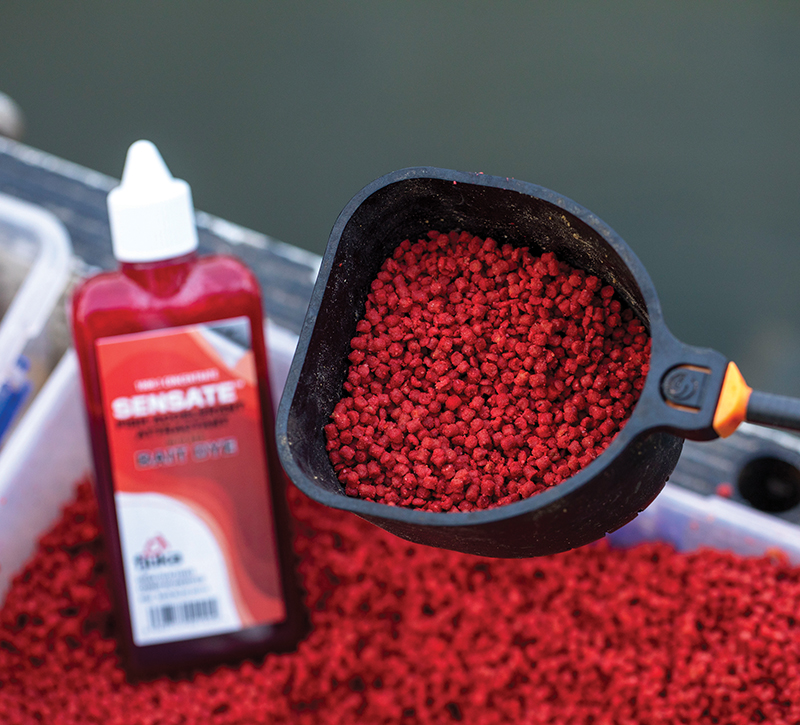 Based on my first experiment, quite a lot! I was fishing for a mixture of fish on pellets, on the bottom in about five feet of water. I tried dying both micros and expanders red, and found I got fewer bites than I did feeding natural coloured baits, which had also been doused in the ‘neutral’ Sensate attractant to keep the test fair.
Based on my first experiment, quite a lot! I was fishing for a mixture of fish on pellets, on the bottom in about five feet of water. I tried dying both micros and expanders red, and found I got fewer bites than I did feeding natural coloured baits, which had also been doused in the ‘neutral’ Sensate attractant to keep the test fair.
I did catch on the red pellets, but it just seemed fish took much longer to respond to them; I concluded that the red bait was just so radically different to what the fish were used to seeing that they shied away from them.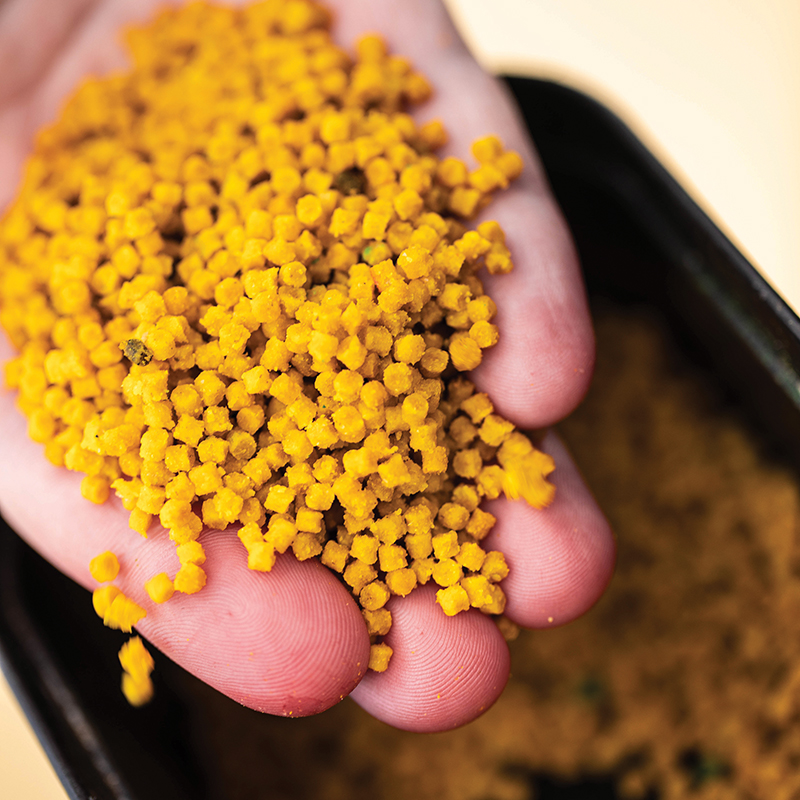 Next, I tried yellow dye. This seemed much better, but hand on heart I couldn’t say it was any better than normal coloured, Sensate flavoured fishery pellets and expanders. I’d say it was just as good. Maybe yellow worked better than red because it was a closer match to what the fish were used to?
Next, I tried yellow dye. This seemed much better, but hand on heart I couldn’t say it was any better than normal coloured, Sensate flavoured fishery pellets and expanders. I’d say it was just as good. Maybe yellow worked better than red because it was a closer match to what the fish were used to?
Despite this inconclusive result in terms of what was better, I drove home from this first session quite happy. One thing that had been firmly established was that colour definitely had the potential to make fish more wary, and by implication this meant that getting it right on a given day would make them feed more confidently.
Mix It Up
My next move came after a chat with my old pal Tommy Pickering. He had been using the dyes to create a mixture of different coloured pellets, then mixing them with fishery pellets to create a multicoloured micro mix.
I loved this idea. To me, this could help solve the original problem I mentioned of a pale expander standing out against uniformly dark micros, by mixing up the colour profile. It also meant I could present any other colour hook bait without it looking unnatural. And who’s to say such a diverse and vibrant mix of colour on the bottom wouldn’t pull more fish in?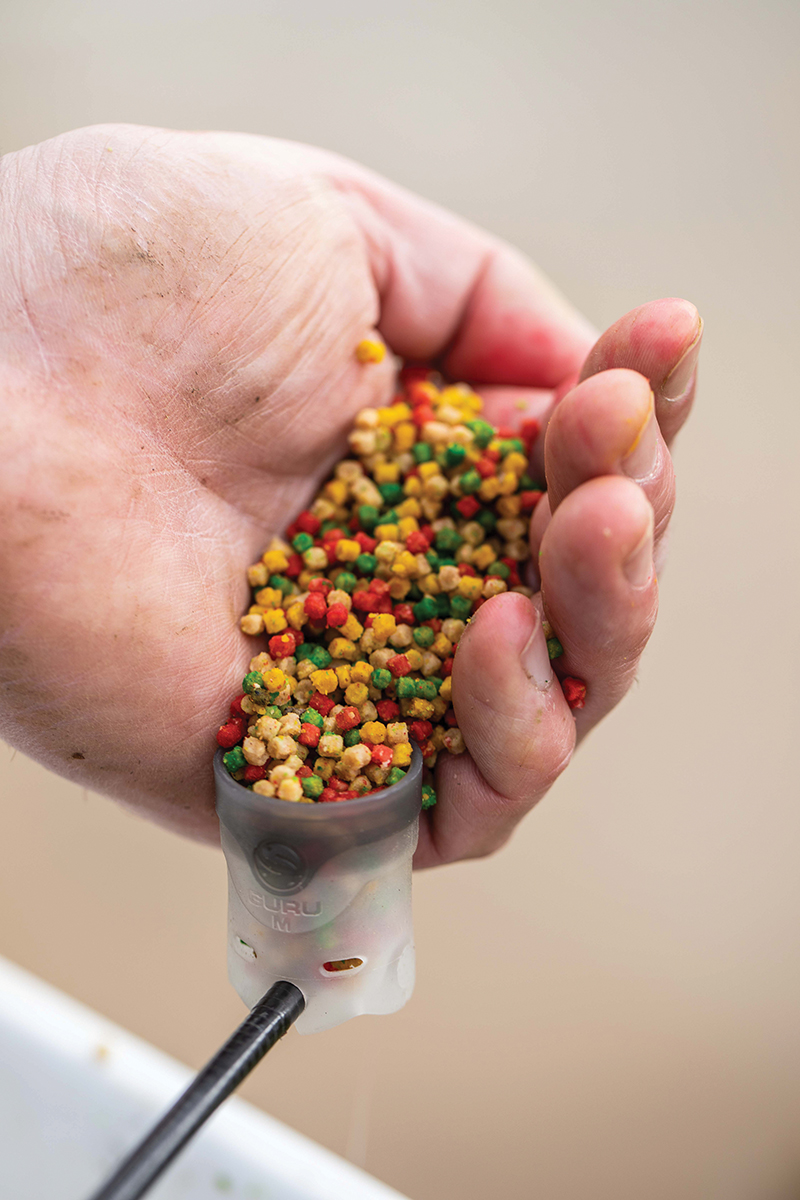 A couple of duff pegs followed where I struggled to make much sense of anything (yes, I do draw badly every now and then), but over the next few weeks I became increasingly confident with this – and the more I talked to Tommy, the more I was happy as he was bagging up doing this too!
A couple of duff pegs followed where I struggled to make much sense of anything (yes, I do draw badly every now and then), but over the next few weeks I became increasingly confident with this – and the more I talked to Tommy, the more I was happy as he was bagging up doing this too!
Although I was no longer matching the hatch as such, I was in effect going one better – mixing up the hatch!
Catching Carp
Nothing stays the same for long, and by now we were moving to warmer weather and I was starting to try hard pellets. We found by accident that the Sensate Dyes were perfect for dying hard pellets too – as once dried, the pellets took on the colour, but didn’t go off.
I have used red hard pellets before, both as a change bait when fishing on the bottom, and quite regularly when mugging. I’m not sure how much science there is here, but in my head a darker red pellet stands out against the sky better than a light pellet – so the fish coming up for a gob can home in on it easier.
The other great thing about adding the Sensate dyes to the pellets is that I have found it helps them all to sink when I feed them – unlike quite a few fishery pellets, which seem to contain a few ‘stragglers’ that float.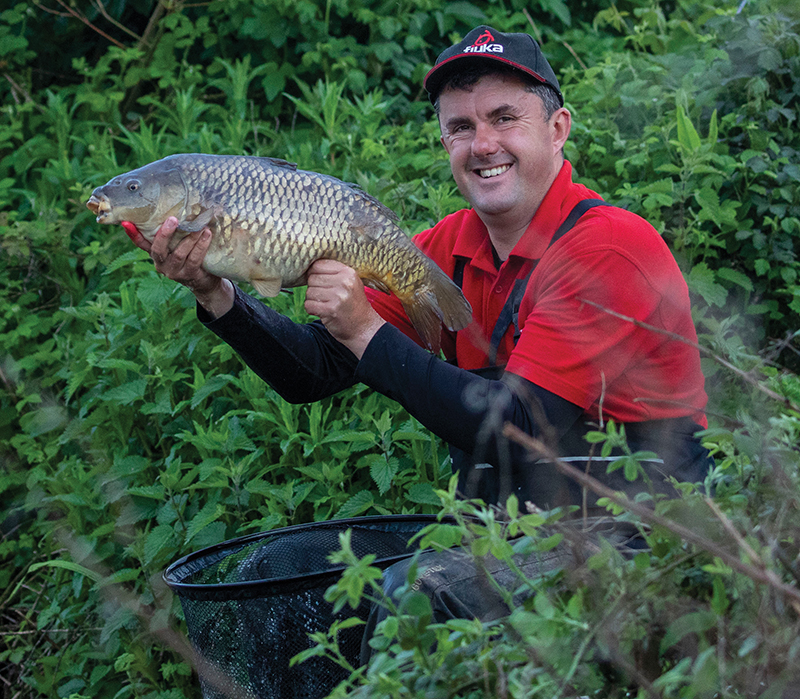 Once again, red pellets have been brilliant here for me so far this year as a change bait. I seem to find that if you put one on, you can generally expect a quick bite or two. However, if it’s one of those days when you are sitting and waiting, you are generally better switching back to a natural pellet.
Once again, red pellets have been brilliant here for me so far this year as a change bait. I seem to find that if you put one on, you can generally expect a quick bite or two. However, if it’s one of those days when you are sitting and waiting, you are generally better switching back to a natural pellet.
Another good use for a red pellet as a hook bait is when feeding casters shallow. They are a good alternative to a banded caster, making more of a splash when they enter the water, and often singling out the better fish.
Guide Them In
This thought of a darker (red) pellet being better for fish to see when higher in the water column set me thinking about margin fishing too.
One of my favourite baits to feed down the edge is micro pellets, but as we all know they can often be something of a poisoned chalice, bringing a lot of fish into an area, but eventually spreading out on the bottom and causing line bites and foul hookers. Having watched a few underwater films, I did wonder whether this was because the fish couldn’t see them – after all, their brown colour blends in perfectly with the bottom. I also wondered whether a pile of bright red micros might prove a good visual marker for the fish to home in on when patrolling.
I always like to fish a big, heavy bait like double corn, or a yellow Fjuka Fatboy down the edge to avoid foul hookers, and I also hoped the contrast between the red feed and yellow hook bait might prove appealing.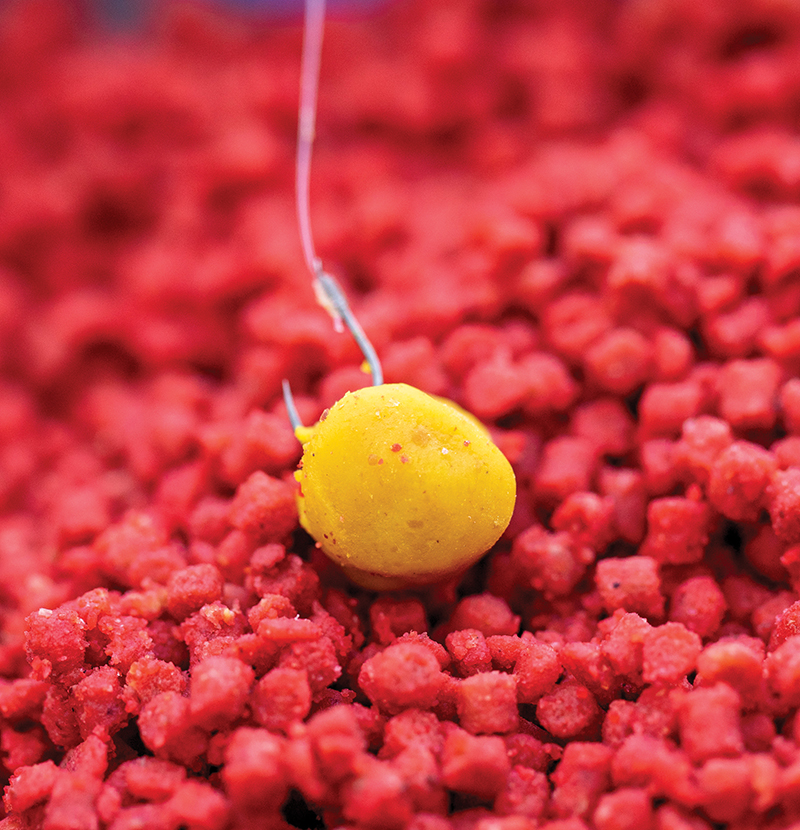 In contrast to my last experiment with an ‘all red’ pellet mix, this has worked really well on a couple of occasions. The fish seem to home in quickly, and I managed to keep fish settled for longer.
In contrast to my last experiment with an ‘all red’ pellet mix, this has worked really well on a couple of occasions. The fish seem to home in quickly, and I managed to keep fish settled for longer.
As I write this, we are in the middle of May and I have only had the chance to try this a handful of times, so it’s hard to draw any concrete conclusions but I’m very impressed with my early experiments.
So to sum up, I think Tommy’s mixture of different coloured pellets is a master stroke, creating a bright pile of bait for fish to home in on without singling out a particular colour that isn’t natural to them. My love of dyed (red) hard pellets continues. As for other colours? More experimentation is needed – but a range of change baits is always good. And feeding coloured micros down the edge has shown some promising results too.
Perhaps the biggest lesson to get across here though is the need to think about bait colour, and that it really does make a difference. I for one have even guilty of not thinking about it enough in the past, but there are tweaks to be made that can bring real improvements to your results.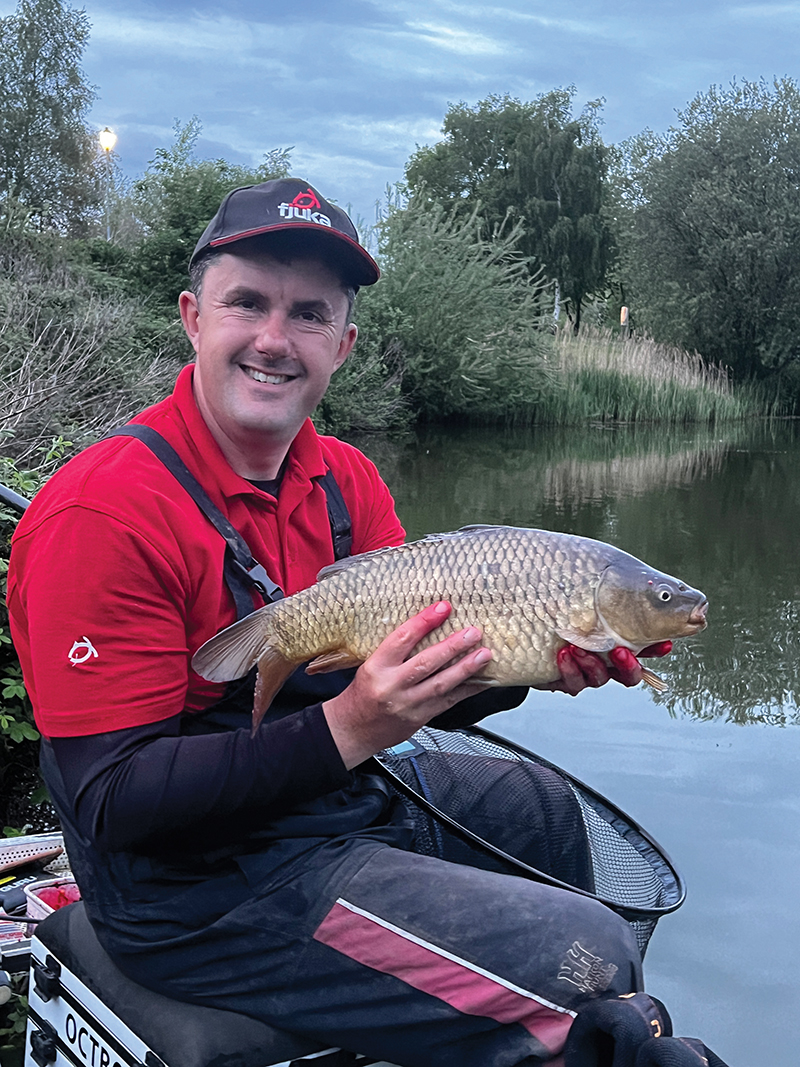
- Log in or register to post comments













